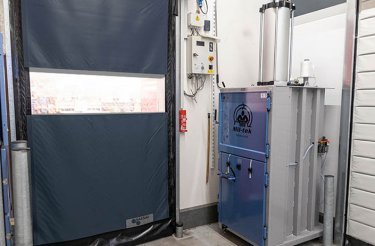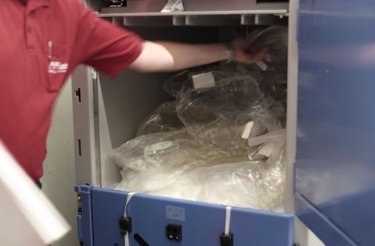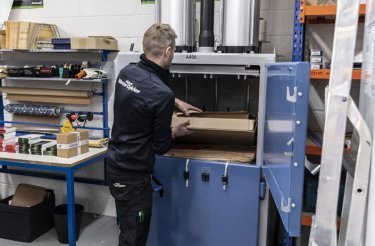
What is a Trash Baler?
Your Complete Guide to Balers and Baling Presses. Learn how these machines function and why they’re a key tool in modern trash and recycling operations.
What is a Trash Baler?
An Essential Machine for Trash and Recycling Management
A trash baler, recycling baler, or simply just a baler – is a machine designed to compress materials like cardboard, plastic, and paper into tightly packed, easy-to-handle bales.
These bales simplify the recycling process, reduce handling costs, and free up valuable space.
For many businesses, balers are a practical way to optimize waste management, cut disposal expenses, and strengthen their sustainability efforts.

Baler vs. Bailer – What’s the difference?
At first glance, “baler” and “bailer” are separated by just a single letter, yet they describe two completely different types of equipment.
- A baler is a trash-handling machine designed to compress materials such as cardboard, plastic, and aluminum cans into tightly packed bales for easier recycling and transport.
- A bailer, however, has nothing to do with trash. It’s a slim, lightweight instrument used to draw groundwater for testing and monitoring. The device, equipped with a one-way valve, is lowered into a well and uses hydrostatic pressure to trap and lift water to the surface for quality analysis.
Here’s an easy way to keep them straight: balers tackle trash and reduce landfill impact, while bailers help monitor and protect the health of underground water supplies.
You might also want to check out: How Does a Baler Differ from a Compactor?

What is a trash baler? – How it Boosts trash management efficiency
A baler – mistakenly called a bailer from time to time – is a machine for businesses that handle recyclable trash. Have you ever wondered, “What is a baler?” or “What does a baler do?”, the answer is straightforward: it compresses easy-to-handle bales of materials such as cardboard, plastic, and metal cans. Making the trash materials far easier to store, move, and recycle.
No matter if you’ve been typing “baler or bailer?” into a search bar, “baler or bailer?”, you can be sure that a baler is the right term when talking about trash-handling machines. Here’s how a baler can make a difference for your business:
- Cuts trash volume – A baler can compress materials by as much as 90%, freeing up valuable space.
- Reduces removal expenses – With fewer loads to haul away, your business can cut down on pickup frequency and trash service fees.
- Strengthens recycling profile – Separating and preparing recyclables becomes faster and more efficient.
- Impoves a safer wokspace – You reduce the chances of fires, eliminate messy clutter, and lower the risk of accidents.
- Creates additional income – Cardboard, plastics, and other baled materials can be sold to recycling facilities, creating an extra revenue stream.
Explore Our Solutions
If you’re wondering about the difference between bailer and baler, here’s the key takeaway: a baler is the machine you want for efficient trash handling and recycling.
Ready to find the right fit?
Browse our selection of cardboard balers and other recycling equipment designed to simplify your trash management process and make recycling easier than ever.

Upgrade the way you are handling trash today!
Get professional guidance on selecting the perfect baler for your business needs.
Simply fill out the form, and our team will get back to you as soon as possible.
What Does a Baler Do?
A baler is a machine that compresses recyclable trash – such as cardboard, plastic, and paper – into bales, making storage, transport, and recycling far more efficient.
Baler vs. Bailer – Getting It Right
When it comes to trash management equipment, the correct term is baler. A bailer is something entirely different, it’s used to pull up groundwater samples for environmental testing.
Materials You Can Bale
Balers can handle cardboard, plastics, polystyrene, aluminum cans, textiles, and more. The right model for you will depend on the volume and type of trash your business produces.
Baler Pricing
The cost of a baler varies depending on its size, capacity, and features.